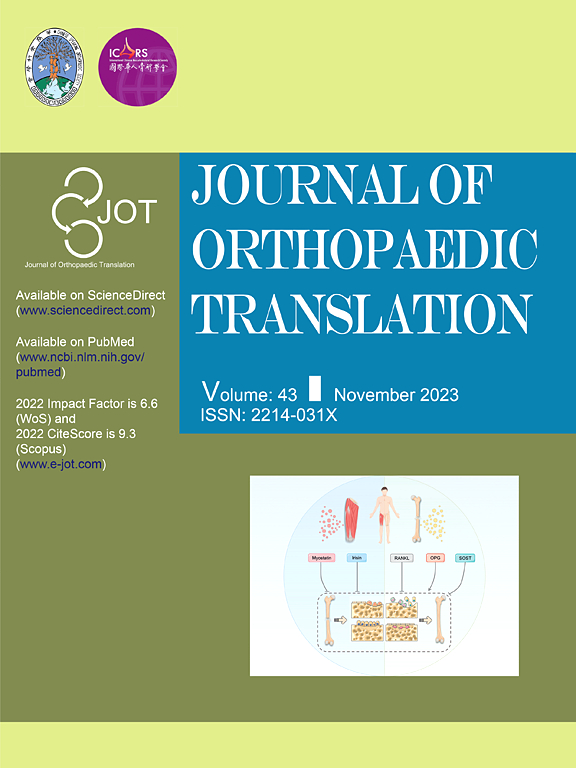High-dose romosozumab promoted bone regeneration of critical-size ulnar defect filled with demineralized bone matrix in nonhuman primates
IF 5.9
1区 医学
Q1 ORTHOPEDICS
引用次数: 0
Abstract
Background
Large bone defects are challenging to manage clinically and usually require treatment with bone graft or bone graft substitute. This study evaluated the effect of romosozumab, a sclerostin antibody, in combination with demineralized bone matrix (DBM) on bone regeneration in a critical-size ulnar defect model in nonhuman primates.
Methods
In cynomolgus monkeys (N = 22, male, 10–12 years old), a full-cortex bone defect (0.5 cm long) was created in the left ulnar shaft and filled with DBM. Animals were randomized to receive vehicle (n = 10) or romosozumab (n = 12; 30 mg/kg) subcutaneously, every 2 weeks for 28 weeks. Radiographs of the left ulna were taken every 2 weeks for 28 weeks to monitor bone regeneration response. Ulnae were excised and analyzed by ex-vivo x-ray and micro-computed tomography (micro-CT) to evaluate bone repair, and lumbar vertebrae were excised for bone histomorphometric analysis to evaluate the systemic anabolic response.
Results
In-vivo and ex-vivo x-ray images of surgical ulnae demonstrated that the critical-size ulnar defect fully bridged in 3 romosozumab-treated monkeys at week 28 but not in any vehicle-treated monkey. Micro-CT analysis demonstrated that average new bone volume and new bone area within the defect region were 118 % and 105 % greater, respectively, with romosozumab versus vehicle. Trabecular bone volume per tissue volume and trabecular thickness of lumbar vertebral body were 72 % and 92 % greater, and eroded surface was significantly lower with romosozumab versus vehicle.
Conclusion
High-dose romosozumab in combination with DBM improved bone regeneration in a critical-size ulnar defect model and increased bone mass in non-surgical bone in nonhuman primates.
The translational potential of this article
Clinical management of large bone defect is complex and challenging. More effective management is needed. This paper reports the first nonhuman primate study that evaluated high-dose romosozumab in combination with demineralized bone matrix in a critical-size defect model and provides perspective for the future research evaluating the combination of romosozumab and bone graft or bone graft substitutes in various relevant clinical conditions.
大剂量romosozumab促进非人灵长类动物脱矿化骨基质填充尺骨缺损的骨再生
背景:大型骨缺损的临床治疗具有挑战性,通常需要骨移植或骨替代治疗。本研究评估了romosozumab(一种硬化蛋白抗体)与去矿化骨基质(DBM)联合使用对非人灵长类动物尺骨缺损模型骨再生的影响。方法食蟹猴22只,雄性,10 ~ 12岁,在左尺干处造出长0.5 cm的全皮质骨缺损,并用DBM填充。动物被随机分为两组,一组接受载药(n = 10),另一组接受romosozumab (n = 12;30 mg/kg)皮下注射,每2周一次,连用28周。每2周拍摄左尺骨x线片,连续28周监测骨再生反应。切除尺骨,通过离体x线和微型计算机断层扫描(micro-CT)分析骨修复情况,切除腰椎进行骨组织形态学分析,评估全身合成代谢反应。结果手术后尺骨的体内和离体x线图像显示,3只经romosozumab治疗的猴子在第28周时,临界尺寸的尺骨缺损完全桥接,而没有任何载体治疗的猴子。Micro-CT分析显示,romosozumab与载药相比,缺损区域内的平均新骨体积和新骨面积分别增加了118%和105%。与载药组相比,romosozumab治疗腰椎椎体的每组织体积和小梁厚度分别增加72%和92%,侵蚀面明显减少。结论大剂量romosozumab联合DBM可改善临界尺骨缺损模型的骨再生,增加非人灵长类非手术骨的骨量。大骨缺损的临床治疗是复杂而具有挑战性的。需要更有效的管理。本文报道了首次在临界尺寸缺陷模型中评估高剂量romosozumab与脱矿骨基质联合使用的非人灵长类动物研究,为未来在各种相关临床条件下评估romosozumab与骨移植物或骨移植物替代品联合使用的研究提供了视角。
本文章由计算机程序翻译,如有差异,请以英文原文为准。
求助全文
约1分钟内获得全文
求助全文
来源期刊

Journal of Orthopaedic Translation
Medicine-Orthopedics and Sports Medicine
CiteScore
11.80
自引率
13.60%
发文量
91
审稿时长
29 days
期刊介绍:
The Journal of Orthopaedic Translation (JOT) is the official peer-reviewed, open access journal of the Chinese Speaking Orthopaedic Society (CSOS) and the International Chinese Musculoskeletal Research Society (ICMRS). It is published quarterly, in January, April, July and October, by Elsevier.
 求助内容:
求助内容: 应助结果提醒方式:
应助结果提醒方式:


